North African campaign
| North African campaign | |||||||||
|---|---|---|---|---|---|---|---|---|---|
| Part ofWorld War II | |||||||||
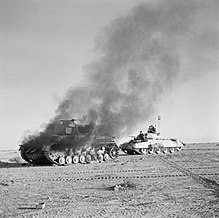 BritishCrusader tankpasses a destroyed and smoking GermanPanzer IVtank duringOperation Crusader,November 1941 | |||||||||
| |||||||||
| Belligerents | |||||||||
|
|
| ||||||||
| Commanders and leaders | |||||||||
| Casualties and losses | |||||||||
TheNorth African campaignofWorld War IItook place inNorth Africafrom 10 June 1940 to 13 May 1943. It included campaigns fought in theLibyanandEgyptiandeserts (Western Desert campaign,also known as the Desert War), inMoroccoandAlgeria(Operation Torch), and inTunisia(Tunisia campaign). The campaign was fought between theAlliesand theAxis Powers.The Allied war effort was dominated by theBritish Commonwealthand exiles fromGerman-occupied Europe.The United States officially entered the war in December 1941 and began direct military assistance in North Africa on 11 May 1942.
Fighting in North Africa started with theItaliandeclaration of war on 10 June 1940. On 14 June, the British11th Hussarsand part of the1st Royal Tank Regiment,(1st RTR) crossed the border from Egypt into Libya and capturedFort Capuzzo.This was followed by an Italiancounter-offensiveinto Egypt and the capture ofSidi Barraniin September. The British recaptured Sidi Barrani in December duringOperation Compass.The Italian10th Armywas destroyed and theGermanAfrika Korpswas dispatched to North Africa in February 1941 inOperation Sonnenblumeto reinforce Italians and prevent an Axis defeat.
Battles for control of Libya and Egypt followed, with advances and retreats until theSecond Battle of El Alameinin October 1942 when the Eighth Army (Lieutenant-GeneralBernard Montgomery) defeated the German–ItalianPanzerarmee Afrikaand forced its remnants into Tunisia. AfterOperation Torch,the Anglo-American landings in North-West Africa in November 1942 and fighting againstVichy Franceforces (which then changed sides), the Allies trapped about 250,000 German and Italian personnel in northern Tunisia, forcing their surrender in May 1943.
Information gleaned via BritishUltracode-breaking was important in the Allied victory in North Africa. TheItalian campaignfollowed, which culminated in the downfall of the Fascist government in Italy and the elimination of Germany's main European ally. German and Italian forces committed atrocities against prisoners of war andJewish,BerberandArabpopulations.
Western Desert campaign[edit]
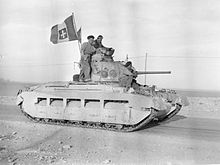

On 10 May 1940, theWehrmachtstarted theBattle of France(orWestfeldzug). Six weeks later, France surrendered. TheArmistice at Compiègnetook place on 22 June 1940 leaving theVichy governmentin control of French territory not occupied by Germany.
On 10 June, theKingdom of Italyaligned itself withNazi Germanyand declared war uponFranceand theUnited Kingdom.[13]British forces (along with Indian and Rhodesian troops) based inEgyptwere ordered to take defensive measures, but to avoid provocation as much as possible.[14]However, on 11 June they began a series of raids against Italian positions in Libya.[15]Following the defeat of France on 25 June, Italian forces inTripolitania– facing French troops based inTunisia– redeployed toCyrenaicato reinforce theItalian Tenth Army.[16]This, coupled with the steadily degrading equipment of the British forces, led GeneralArchibald Wavellto order an end to the raids and place the defence of the Egyptian border with a small screening force.[17]
ItaliandictatorBenito Mussoliniordered the Tenth Army toinvade Egyptby 8 August. Two days later, no invasion having been launched, Mussolini ordered MarshalGrazianithat, the moment German forces launchedOperation Sea Lionto invade Great Britain, he was to attack.[18]Beaten in the Battle of Britain, the German invasion never took place. On 8 September, the Italians – hampered by a lack of transport, enfeebled by the low level of training among officers, and weakened by the state of its supporting equipment[16]– were ordered to invade Egypt the following day. The battle plan was to advance along the coastal road while limited armoured forces operated on thedesertflank.[17]
To counter the Italian advance, Wavell ordered his screening forces to harass the advancing Italians, falling back towardsMersa Matruh,where the main British infantry force was based. Positioned on the desert flank was the7th Armoured Division,which would strike at the flank of the Italian force.[19][20]
By 16 September, the Italian force had advanced toMaktila,around 130 kilometres (80 mi) west of Mersa Matruh, where they halted due to supply problems.[21]Despite Mussolini urging them to carry on, Graziani ordered his men to dig in aroundSidi Barrani,and fortified camps were established in forward locations; additional troops were also positioned behind the main force.[22]In response to the dispersed Italian camps, the British planned a limited five-day attack,Operation Compass,to strike at these fortified camps one by one.[23][24]The British Commonwealth force, totalling 36,000 men,[25]attacked the forward elements of the 10-division-strong Italian army on 9 December.[26]Following their initial success, the forces of Operation Compass[27]pursued the retreating Italian forces.[28]In January, the small port atBardiawas taken,[29]soon followed by the seizure of the fortified port ofTobruk.[30]
Some 40,000 Italians were captured in and around the two ports, with the remainder of the Tenth Army retreating along the coast road back toEl Agheila.Richard O'Connorsent the 7th Armoured Division across the desert with a small reconnaissance group. It reachedBeda Fommsome ninety minutes before the Italians, cutting off their retreat. Although they tried desperately to overcome the British force at theBattle of Beda Fomm,the Italians were unable to break through, and the remnants of the retreating army surrendered. Over ten weeks Allied forces had destroyed the Italian Tenth Army and reached El Agheila, taking 130,000 prisoners of war in the process.[31][32][33]
Mussolini requested help from his German allies, while the ItalianComando Supremo( "high command" ) speedily sent several large motorized and armoured forces to protect their colonies inNorth Africa.[34]This greatly expanded reinforcement included the soon-to-be-renownedArieteArmoured division under GeneralEttore Baldassarre.[35]Meanwhile, the Germans hastily assembled a motorized force, whose lead elements arrived inTripoliin February. This relatively small expeditionary force, termed theAfrika KorpsbyAdolf Hitler,was placed under the command ofErwin Rommel.His orders were to reinforce the Italians and block Allied attempts to drive them out of the region.[36][37]However, the initial commitment of only one panzer division and subsequently, no more than two panzer and one motorized divisions, indicated the limited extent of German involvement and commitment to this theatre of operations.[35]The bulk of the reinforcements were Italian and therefore it was up to the Italians to do the bulk of the fighting. The forward Allied force – now namedXIII Corps– adopted a defensive posture and over the coming months was built up, before most of its veteran forces wereredeployed to Greeceto counter the German invasion there. In addition, the 7th Armoured Division was withdrawn to the Nile delta.[38][39][40]The veteran forces were replaced by inexperienced newcomers, ill-equipped to face German armour.[41]
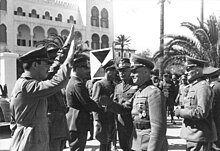
Although Rommel had been ordered to simply hold the line, anarmoured reconnaissancesoon became a full-fledged offensive from El Agheila in March.[36][37]In March–April, Allied forces were forced back[42]and leading general officers captured. TheAustralian 9th Infantry Divisionfell back to the fortress port of Tobruk,[43]and the remaining British andCommonwealthforces withdrew a further 160 kilometres (100 mi) east to the Libyan–Egyptian border.[44]WithTobruk under siegeby the main Italian-German force, a small battlegroup continued to press eastwards. Capturing Fort Capuzzo and Bardia in passing, it then advanced into Egypt, and by the end of April it had taken Sollum and the tactically importantHalfaya Pass.Rommel garrisoned these positions, reinforcing the battle-group and ordering it onto the defensive.[45][46]
Though isolated on land, Tobruk's garrison continued to receive supplies and replacements, delivered by theRoyal Navyat night. Rommel's forces did not have the strength or training to take the fortress. This created a supply problem for his forward units. His front-line positions at Sollum were at the end of an extended supply chain that stretched back to Tripoli and had to bypass the coast road at Tobruk. Further, he was constantly threatened with a breakout of the British forces at Tobruk.[47]Without Tobruk in Axis hands, further advances into Egypt were impractical.[48][49]
The Allies launched a small-scale counter-attack calledOperation Brevityin an attempt to push Axis forces off the key passes at the border, with some initial success. However they could not hold the advance positions and followedBrevityup with a much larger-scale offensive,Operation Battleaxeintended to relieve the siege at Tobruk, but this operation also failed.
Following the failure of Operation Battleaxe, Archibald Wavell was relieved of command and replaced byClaude Auchinleck.TheWestern Desert Forcewas reinforced with a second corps,XXX Corps,with the two corps forming theEighth Army.Eighth Army was made up of army forces from the Commonwealth nations, including theBritish Army,theAustralian Army,theIndian Army,theNew Zealand Army,theSouth African Army,and theSudan Defence Force.There was also a brigade ofFree FrenchunderMarie-Pierre Koenig.
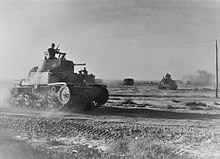
The new formation launched a new offensive,Operation Crusader,in November. After a see-saw battle, the70th Divisiongarrisoning Tobruk was relieved and the Axis forces were forced to fall back. By January 1942, thefront linewas again at El Agheila.
After receiving supplies and reinforcements from Tripoli, the Axis attacked again, defeating the Allies in theBattle of Gazalain June andcapturing Tobruk.The Axis forces drove the Eighth Army back over the Egyptian border, but their advance was stopped in July only 90 miles (140 km) fromAlexandriain theFirst Battle of El Alamein.
Of great significance, on 29 June reports of British military operations in North Africa sent to Washington by the US military attaché in Cairo,Bonner Fellers,no longer used the compromised"Black Code"which the Axis forces had been reading, so the Axis could no longer learn of British "strengths, positions, losses, reinforcements, supply, situation, plans, morale etc" as they had since 1940.
General Auchinleck, although he had checked Rommel's advance at the First Battle of El Alamein, was replaced by GeneralHarold Alexander.Lieutenant-GeneralWilliam Gottwas promoted from XIII Corps commander to command of the entire Eighth Army, but he was killed when his aircraft was intercepted and shot down over Egypt. He was replaced by Lieutenant-GeneralBernard Montgomery.
At the end of June, Axis forces made a second attempt to break through the Allied defences at El Alamein atAlam Halfa,but were unsuccessful. After a lengthy period of build-up and training, the Eighth Army launched a major offensive, decisively defeating the Italian-German army in theSecond Battle of El Alameinin late October, driving Axis forces west and capturing Tripoli in mid-January 1943. By February, the Eighth Army was facing the Italian-GermanPanzerArmy near theMareth Lineand came under command of Alexander's18th Army Groupfor the concluding phase of the war in North Africa – theTunisia campaign.
Operation Torch[edit]
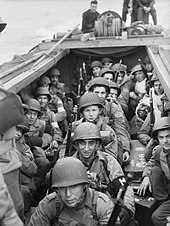
Operation Torch in November 1942 was a compromise operation that met the British objective of securing victory in North Africa while allowingAmerican armed forcesthe opportunity to engage in the fight against Nazi Germany on a limited scale.[50]In addition, asJoseph Stalin,the leader of theSoviet Union,had long been pleading for a second front to be opened to engage the Wehrmacht and relieve pressure on theRed Army,it provided some degree of relief for the Red Army on theEastern Frontby diverting Axis forces to the North African theatre. Over half the GermanJu 52transport planes that were needed to supply theencircled Axis forces at Stalingradwere tied up supplying Axis forces in North Africa.[51]
Senior U.S. commanders were strongly opposed to proposed landings in North-West Africa. After the western AlliedCombined Chiefs of Staff(CCS) met in London on 30 July 1942 GeneralGeorge Marshalland AdmiralErnest Kingdeclined to approve the plan. Marshall and other U.S. generals advocated theinvasion of northern Europelater that year, which the British rejected.[52][53]After Prime MinisterWinston Churchillpressed for a landing inFrench North Africain 1942, Marshall suggested instead to PresidentFranklin D. Rooseveltthat the U.S. abandon theGermany firststrategy and take the offensive in the Pacific. Roosevelt said it would do nothing to help Russia.[54]With Marshall unable to persuade the British to change their minds,[55]President Roosevelt gave a direct order thatOperation Torchwas to have precedence over other operations and was to take place at the earliest possible date, one of only two direct orders he gave to military commanders during the war.
The landings started on 8 November, and finished on 16 November. In an attempt to pincer German and Italian forces, Allied forces (American and British Commonwealth) landed in Vichy-held French North Africa under the assumption that there would be little to no resistance. Nevertheless, Vichy French forces put up a strong and bloody resistance to the Allies inOranandMorocco,but not inAlgiers,where acoup d'étatby the French resistance on 8 November succeeded in neutralizing theFrench XIX Corpsbefore the landing and arresting the Vichy commanders. Consequently, the landings met no practical opposition in Algiers, and the city was captured on the first day along with the entire Vichy African command. After three days of talks and threats, GeneralsMark ClarkandDwight Eisenhowercompelled Vichy AdmiralFrançois Darlanand GeneralAlphonse Juinto order the cessation on 10–11 November of armed resistance from Vichy forces in Oran and Morocco, promising to make Darlan the head of a Free French administration. During Operation Torch, Americans fought Vichy French and German navy vessels in theNaval Battle of Casablanca,which ended in an American victory.
The Allied landings prompted the Axis occupation of Vichy France (Case Anton) including an attempt to capture the French fleet at Toulon, which did them little good, as themain portion of the fleet was scuttledto prevent their use by the Axis.
TheVichy Armyin North Africa joined the Allies.
Tunisian campaign[edit]
Following the Operation Torch landings – from early November 1942 – the Germans and Italians initiated a buildup of troops in Tunisia to fill the vacuum left by Vichy troops which had withdrawn. During this period of weakness, the Allies decided against a rapid advance into Tunisia while they wrestled with the Vichy authorities. Many of the Allied soldiers were tied up in garrison duties because of the uncertain status and intentions of the Vichy forces.
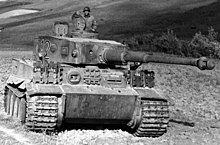
By mid-November, the Allies were able to advance into Tunisia, but only in single division strength. By early December, the Eastern Task Force – which had been redesignated as theBritish First Armyunder Lieutenant-GeneralKenneth Anderson– was composed of theBritish 78th Infantry Division,British 6th Armoured Division,1st Parachute Brigade,No. 6 Commandoand elements ofUS 1st Armored Division.But by this time, one German and five Italian divisions had been shipped from Europe and the remoteness of Allied airfields from the front line gave the Axis clear air superiority over the battlefield. The Allies were halted and pushed back having advanced eastwards to within 30 kilometres (19 mi) of Tunis.
In early December, the Allies were met with the reality that they would not be successful in capturing the key cities of Tunis and Bizerta. The air campaigns by the Axis forces proved to be a difficult challenge for the British forces. However, the Allies were left with the advantage of having secured the island of Malta, enabling the Allies to carry out future aerial operations. Additionally, on land, allied British and American forces were able to hold onto their possessions. On December 4, 1942, the Allied Force Headquarters in North Africa reported that military operations were ongoing in the Tebourba area. The Axis powers attempted a second counter-attack in the neighborhood of Tebourba following their failed attempt on December 1. The attack was successfully repulsed by the Allied powers, and the enemy sustained significant damage to their weaponry. During the winter, there followed a period of stalemate during which time both sides continued to build up their forces. By the new year, the British First Army had one British, one US and one French Corps (a second British Corps headquarters was activated in April). In the second half of February, in eastern Tunisia, Rommel and von Arnim had some successes against the mainly inexperienced French and US troops, most notably in routing theUS II Corpscommanded by Major GeneralLloyd Fredendallat theBattle of Kasserine Pass.
By the beginning of March, theBritish Eighth Army– advancing westward along the North African coast – had reached the Tunisian border. Rommel and von Arnim found themselves in an Allied "two army" pincer. They were outflanked, outmanned and outgunned. Rommel went back to Germany for health reasons and was substituted by the Italian generalMesse.
The British Eighth Army bypassed the Axis defence on the Mareth Line in late March after harsh fighting[citation needed]and First Army in central Tunisia launched their main offensive in mid-April to squeeze the Axis forces until their resistance in Africa collapsed. The Axis forces surrendered on 13 May 1943 yielding over 275,000prisoners of war.The last Axis force to surrender in North Africa was the 1st Italian Army of general Messe.[57]This huge loss of experienced troops greatly reduced the military capacity of the Axis powers, although some Axis troops escaped Tunisia. This defeat in Africa led to all Italian colonies in Africa being captured.[citation needed]
Intelligence[edit]
Axis[edit]
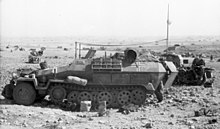
The Axis had considerable success in intelligence gathering through radio communication intercepts and monitoring unit radio traffic. The most important success came through intercepting the reports of Fellers, the US military attaché in Egypt. He had been tasked by Marshall with providing detailed reports on the military situation in Africa.[58]Fellers talked with British military and civilian headquarters personnel, read documents and visited the battlefront. Known to the Germans as "die gute Quelle" (the good source) or more jokingly as 'the little fellow', he transmitted his reports back to Washington using the "Black Code" of theUS State Department.However, in September 1941, the Italians had stolen a code book containing the Black Code, photographed it and returned it to the US embassy in Rome.[59]The Italians shared parts of their intercepts with their German allies. In addition the "Chiffrierabteilung"(German military cipher branch) were soon able to break the code. Fellers' reports were very detailed and played a significant role in informing the Germans of allied strength and intentions between January and June 1942
In addition, the ItalianServizio Informazioni Segreteor SIS code-breakers were able to successfully intercept much radio encrypted signals intelligence (SIGINT) from British aircraft traffic as well as first-class ciphers from British vessels and land bases, providingSupermarina(Regia Marina) with timely warnings of Allied intentions in the Mediterranean.[60]Indeed, so successful was the Italian SIS in handling the bulk of Axis naval intelligence in the Mediterranean, that "Britain's offensive use of SIGINT was largely negated by Italy's defensive SIGINT."[61]
The Afrika Korps had the intelligence services of the 621st Signals Battalion mobile monitoring element which arrived in North Africa in late April 1941,[62]commanded by Hauptmann Alfred Seeböhm. The 621st Signals Battalion monitored radio communications among British units. Unfortunately for the Allies, the British not only failed to change their codes with any frequency, they were also prone to poor radio discipline in combat. Their officers made frequent open, uncoded transmissions to their commands, allowing the Germans to more easily identify British units and deployments.[58]The situation changed after a counterattack during the Battle of Gazala resulted in the 621st Signals Battalion being overrun and destroyed, and a number of their documents captured, alerting British intelligence to the problem.[63]The British responded by instituting an improved call signal procedure, introducing radiotelephonic codes, imposing rigid wireless silence on reserve formations, padding out real messages with dummy traffic, tightening up on their radio discipline in combat and creating an entire fake signals network in the southern sector.[63]
Allies[edit]

Allied codebreakers read much enciphered German message traffic, especially that encrypted with theEnigma machine.The Allies'Ultraprogramme was initially of limited value, as it took too long to get the information to the commanders in the field, and at times provided information that was less than helpful.[64]In terms of anticipating the next move the Germans would make, reliance on Ultra sometimes backfired. Part of the reason the initial German attacks in March 1941 were so successful was that Ultra intercepts had informed Wavell that OKW had clearly directed Rommel not to take any offensive action, but to wait until he was further reinforced with the 15th Panzer Division in May.[65]Rommel received this information, but placed more value on his own assessment of the situation. Trusting that the Germans had no intention of taking major action, the British command did not respond until it was too late.[66]Furthermore, Rommel did not generally provide OKW or the ItalianComando Supremodetails of his planned operations, for he thought the Italians too prone to leak the information. Thus on 21 January 1942, when Rommel struck out on his second offensive from El Agheila,Comando Supremowas just as surprised to learn of it as the British were.[67]Ultra intercepts provided the British with such information as the name of the new German commander, his time of arrival, and the numbers and condition of the Axis forces, but they might not correctly reveal Rommel's intentions.

The primary benefit of Ultra intercepts to the effort in North Africa was to aid in cutting the Axis supply line to Tunisia. Ultra intercepts provided valuable information about the times and routes of Axis supply shipments across the Mediterranean. This was critical in providing the British with the opportunity to intercept and destroy them. During the time when Malta was under heavy air attack, the ability to act on this information was limited, but as Allied air and naval strength improved, the information became instrumental to Allied success. It is estimated that 40% to 60% of Axis supply shipping was located and destroyed due to decrypted information.[68][69]However, this claim is strongly disputed by the authorsVincent P. O'Haraand Enrico Cernuschi (2013) who claim that historians likeF.H. Hinsleyhave greatly exaggerated the effects of Ultra. For example, they claim that intelligence provided by Ultra had little impact in stopping Italian convoys reaching North Africa. Of the 2.67 million tons of materiel, fuel, and munitions shipped to Africa – nearly all in Italian vessels and under Italian escort – 2.24 million tons managed to arrive despite the best efforts of Ultra and the British Navy to prevent it.[70]In effect, "Ultra did not deny the Axis armies the supplies they needed to reach the Nile."[61]
Heavy losses of German paratroopers during theBattle of Crete,made possible by Ultra warnings of the drop times and locations, meant that Hitler hesitated in attacking Malta,[71]which aided the British in gaining control of the Mediterranean, as did the losses of the Italian Navy at theBattle of Cape Matapan.[72]To conceal the fact that German coded messages were being read, a fact critical to the overall Allied war effort, British command required a flyover mission be carried out before a convoy could be attacked in order to give the appearance that a reconnaissance flight had discovered the target.
Atrocities[edit]
The North African campaign was often labeled a "war without hate", a pure military clash in the desert without the partisan murders andethnic cleansingthat was occurring across Europe. This view has been challenged by recent historians, given that there were indeed many civilians who lived in the region,[73]and the campaign was marked by numerous atrocities and abuses by both Italian and German forces towards Allied prisoners of war and localJewish,Berber,and Arab populations.[74]These acts were often motivated by racism and antisemitism.[75]
Aftermath[edit]

After victory by the Allies in the North African campaign, the stage was set for theItalian campaignto begin. Theinvasion of Sicilyfollowed two months later. Nearly 400,000 Axis and Allied troops were lost, injured or died of disease by the end of the North African campaign.
See also[edit]
- List of British military equipment of World War II
- List of equipment of the United States Army during World War II
- List of French military equipment of World War II
- List of German military equipment of World War II
- List of Italian Army equipment in World War II
- List of North African campaign battles
- North African campaign timeline
- Timelines of World War II by year:1940/1941/1942/1943
Notes[edit]
Footnotes[edit]
- ^abcdNovember 1942 to May 1943.
- ^abcd8–11 November 1942. Vichy officially pursued a policy ofarmed neutralityand conducted military actions against armed incursions from Axis and Allied belligerents. The pledging of allegiance of the Vichy troops in French North Africa to the Allies convinced the Axis that Vichy could not be trusted to continue this policy, so they invaded and occupied the French rump state (Case Anton)
- ^abDarlan joined the Allies in November 1942, ordering the French Army of Africa to cease fire and unite with theFree French,and became High Civilian and Military Commissioner in French North Africa until his death on the 24th of December
- ^Historian Giorgio Rochat wrote:Sono circa 400.000 i prigionieri fatti dagli inglesi in Etiopia e in Africa settentrionale, 125.000 presi dagli americani in Tunisia e in Sicilia, 40.000 lasciati ai francesi in Tunisia[ "There were about 400,000 prisoners taken by the British in North Africa and in Ethiopia, 125,000 taken by the Americans in Tunisia and Sicily, 40,000 by the French in Tunisia" ][9]Considering that about 100,000 Italian prisoners were taken in East Africa and that prisoners taken by the Americans were mainly in Sicily, the total is around 340,000–350,000.[citation needed]
Citations[edit]
- ^Higgins, Jenny (2007)."Royal Artillery".Newfoundland Heritage Web Site.
- ^Carell, p. 597
- ^Zabecki, North Africa
- ^Cartier, Raymond.La Seconde Guerre Mondiale, vol4: 1943-Juin1944[The Second World War, vol4: 1943-June 1944]. Press Pocket. p. 40.
- ^Playfair et al p. 460. United States losses from 12 November 1942.
- ^Atkinson, p. 536
- ^Roma: Instituto Centrale Statistica'Morti E Dispersi Per Cause Belliche Negli Anni 1940–45Roma 1957.
- ^Colin F. Baxter. "The War in North Africa, 1940–1943: A Selected Bibliography". 1996. Page 38. 500,000 prisoners are listed as being taken in North Africa, East Africa, and Sicily; as 150,000 POWs were taken in theAllied invasion of Sicilyand about 100,000 inEast Africa,this would leave ~250,000 to be taken in North Africa; 130,000 duringOperation Compass,and 120,000 afterwards.
- ^Rochat, Giorgio.Le guerre italiane 1935–1943. Dall'impero d'Etiopia alla disfatta[The Italian Wars 1935–1943. From the Ethiopian Empire until defeat]. Einaudi. p. 446.
- ^Carrell, p. 596.
- ^Barclay, Mediterranean Operations
- ^Porch, Douglas: "The Path to Victory: The Mediterranean Theater in World War II", 2004, p. 415.
- ^Playfair, p. 109
- ^Playfair, p. 41
- ^Churchill, p. 371
- ^abMacksey, p. 25
- ^abMacksey, p. 38
- ^Macksey, p. 35
- ^Macksey, p. 40
- ^Playfair (2004), pp.209–210
- ^Macksey, p. 47
- ^Macksey, p. 68
- ^Wavell"No. 37628".The London Gazette(1st supplement). 25 June 1946. p. 3261.
- ^Playfair pp. 260–261, 264
- ^Bauer (2000), p.95
- ^Playfair p. 267
- ^Mead, p. 331
- ^Playfair p 271
- ^Playfair, pp. 286–287
- ^Dunn, Jimmy."World War II's Opening Salvoes in North Africa".Tour Egypt.
- ^Playfair, p. 358
- ^"Fall of Bengasi".Time.No. 17 February 1941. 17 February 1941. Archived fromthe originalon 26 June 2010.Retrieved17 December2007.
- ^Wavell in"No. 37628".The London Gazette(1st supplement). 25 June 1946. p. 3268.
- ^Bauer, p.121
- ^abWalker, Ian W. (2003).Iron Hulls Iron Hearts.Trowbridge: The Crowood Press. p. 67.ISBN978-1-86126-646-0.
- ^abJentz, p. 82
- ^abRommel, p. 109
- ^Playfair (1954), p. 289
- ^Playfair (1956), p. 2
- ^Jentz, p. 85
- ^Playfair (1956), pp. 2–5
- ^Playfair (1956), pp. 19–40
- ^Latimer, pp. 43–45
- ^Playfair (1956), pp. 33–35
- ^Playfair (1956), p. 160
- ^Jentz, pp. 128–129, 131
- ^Latimer, pp. 48–64
- ^Playfair (1956), p. 41
- ^Jentz, p. 128
- ^Wilmott, H.P. p.
- ^Hayward, Joel S.A.(1998).Stopped at Stalingrad: The Luftwaffe and Hitler's Defeat in the East, 1942–1943.Lawrence:University Press of Kansas.pp.219,248.ISBN0-7006-1146-0– viaInternet Archive Book Reader.
- ^Zabecki, David T., ed. (1999).World War II in Europe: an encyclopedia.New York:Garland Publishing.p. 1270.ISBN9780824070298.Retrieved10 May2020– viaGoogle Books.
- ^Mackenzie, S.P.(1999).The Second World War in Europe.London:Longman.pp. 54–55.ISBN978-1317864714.Retrieved10 May2020– viaInternet Archive Book Reader.
- ^Ward, Geoffrey C.; Burns, Ken (2014)."The Common Cause: 1939-1944".The Roosevelts: An Intimate History.New York:Alfred A. Knopf.p. 402.ISBN978-0385353069.Retrieved10 May2020– viaGoogle Books.
- ^Routledge Handbook of US Military and Diplomatic History.Hoboken:Taylor & Francis.2013. p. 135.ISBN9781135071028.Retrieved10 May2020– viaGoogle Books.
- ^"AFTA Tiger I Page".armorfortheages.Retrieved28 September2016.
- ^Walker 2006, p. 193
- ^abWil Deac (12 June 2006)."Intercepted Communications for Field Marshal Erwin Rommel".World War II Magazine.Archived fromthe originalon 3 March 2016.Retrieved26 February2013.
- ^Lewin p. 251
- ^Vincent P. O'Hara and Enrico Cernuschi, 2013, p.119.
- ^abVincent P. O'Hara and Enrico Cernuschi, 2013, p.135
- ^Forty 1998,pp. 97, 148.
- ^abLewin p. 252
- ^"Intelligence in North Africa"Archived24 January 2013 at theWayback MachineQuote:Protection of the top secret Ultra source meant that the distribution of Ultra was extremely slow and by the time it had reached the relevant commander it was often out of date and therefore at best useless and at worst dangerously mis-leading.
- ^Verlauf März 1941Archived5 February 2013 at theWayback Machine. In:Der Feldzug in Afrika 1941–1943(deutsches-afrikakorps.de). Retrieved 24 November 2009. Quote: Schuld an dieser Einschätzung sind die Enigma Berichte, aus denen Wavell ersehen kann, dass Rommel lediglich den Auftrag hat, die Syrte-Front zu stabilisieren, und dass sein wichtigster Verband, die 15. Panzerdivision, noch nicht in Afrika eingetroffen ist. Translated: The responsibility for this assessment are the Enigma reports, which can be seen from Wavell that Rommel only has a mandate to stabilize the Sirte front, and that his most important unit, the 15th Panzer Division, has not yet arrived in Africa.
- ^Lewin p. 33 Quote: On 30 March Wavell signalled, 'I do not believe he can make any big effort for another month.'
- ^Lewin pp. 99–101 Quote from Rommel's diary: I had maintained secrecy over the Panzer Group's forthcoming attack eastwards from Mersa el Brega and informed neither the Italian nor the German High Command. We knew from experience that Italian Headquarters cannot keep things to themselves and that everything they wireless to Rome gets round to British ears. However, I had arranged with the Quartermaster for the Panzer Group's order to be posted in everyCantonierain Tripolitinia on 21 January...
- ^Kingsly, Sir Harry"The Influence of ULTRA in the Second World War"Archived22 June 2011 at theWayback Machine
- ^Hinsley, Francis Harry (1993), British intelligence in the Second World War, Cambridge: Cambridge University Press,ISBN978-0-521-44304-3
- ^Vincent P. O'Hara and Enrico Cernuschi, 2013. p.118
- ^"Intelligence in North Africa".topedge.Retrieved28 September2016.
- ^Hinsley, F.H.; Stripp, Alan, eds. (1993), Codebreakers: The inside story of Bletchley Park (OU Press paperback ed.), Oxford: Oxford University Press,ISBN978-0-19-280132-6p 3
- ^Robert Citino,Death of the Wehrmacht: The German Campaigns of 1942,University Press of Kansas, 2007, p. 116.
- ^Patrick Bernhard (1 December 2012). "Behind the Battle Lines: Italian Atrocities and the Persecution of Arabs, Berbers, and Jews in North Africa during World War II".Holocaust and Genocide Studies.26(3): 425–446.doi:10.1093/hgs/dcs054.
- ^Patrick Bernhard,Im Rücken Rommels. Kriegsverbrechen, koloniale Massengewalt und Judenverfolgung in Nordafrika, 1940-1943in:ZfGen Zeitschrift für Genozidforschung, page 83 – 122 ZfGen, Volume 17 (2019), Issue 1–2,ISSN1438-8332,ISSN online: 1438-8332, "the North African Campaign was anything but war without hate. There ere numerous intentional crimes and infringements of the rules of conduct, including the ill treatment and murder of captured enemy soldiers, the plunder of indigenous population, the rape of local woman, as well as exploitation, murder and mass detainment in concentration camps of Arabs, Berbers and Jews which was often motivated by racial and anti-Semitic hatred"
References[edit]
- Atkinson, Rick(2004) [2002].An Army at Dawn: The War in North Africa, 1942–1943.Abacus.ISBN0-349-11636-9.
- Barclay, Brigadier C. N."Mediterranean Operations".GI – World War II Commemoration. Archived fromthe originalon 21 January 1997.Retrieved8 September2010.
- Bauer, Eddy (2000) [1984].The history of World War II(Revised and updated ed.). Great Britain: Silverdale.ISBN978-1-85605-552-9.
- Carell, Paul(1960).Le volpi del deserto. 1941–1943: le armate italo-tedesche in Africa settentrionale[The wolves of the desert. 1941–1943: the Italo-German armies in North Africa]. New York: Bantam.
- Forty, George (1998).The Armies of Rommel.London: Arms and Armour Press.ISBN978-1-85409-379-0.
- Jentz, Thomas L. (1998).Tank Combat in North Africa: The Opening Rounds, Operations Sonnenblume, Brevity, Skorpion and Battleaxe, February 1941 – June 1941.Schiffer Publishing.ISBN0-7643-0226-4.
- Keegan, John(2001).Oxford Companion to World War II.Oxford University Press.ISBN0-19-280666-1.
- Lewin, Ronald (1998) [1968].Rommel As Military Commander.New York: B&N Books.ISBN978-0-7607-0861-3.
- O'Hara, Vincent; Cernuschi, Enrico (Summer 2013). "The Other Ultra: Signal Intelligence and the Battle to Supply Rommel's Attack toward Suez".Naval War College Review.66(3): 117–138.
- Playfair, Major-General I.S.O.;and Molony, Brigadier C.J.C.; with FlynnRN,Captain F.C. & Gleave, Group Captain T.P. (2004) [1st. pub.HMSO1966].Butler, J.R.M(ed.).The Mediterranean and Middle East, Volume IV: The Destruction of the Axis Forces in Africa.History of the Second World War United Kingdom Military Series. Uckfield, UK: Naval & Military Press.ISBN1-84574-068-8.
- Walker, Ian (2006).Iron Hulls, Iron Hearts: Mussolini's Elite Armoured Divisions in North Africa.Ramsbury: Crowood.ISBN1-86126-839-4.
- Willmott, H.P. (1984).June, 1944.Poole, Dorset: Blandford Press.ISBN0-7137-1446-8.
- Zabecki, David T. (2007)."North Africa (1940–1943)".The War.PBS. Archived fromthe originalon 12 April 2010.Retrieved8 September2010.
External links[edit]
- The Jews of North Africa and the HolocaustArchived31 July 2013 at theWayback Machinean e-Newsletter for Holocaust educators byYad Vashem
- BBC's flash video of the North African campaign
- Timeline of the North African campaign
- Canadian World War 2 Online Newspaper Archives – The North African Campaigns, 1940–1943
- North African Campaign Desert War.net
- North African campaign
- 1940s in Africa
- 1940s in Egypt
- 1940s in Libya
- African theatres of World War II
- Battles and operations of World War II involving Australia
- Battles and operations of World War II involving France
- Battles and operations of World War II involving Germany
- Battles and operations of World War II involving India
- Battles and operations of World War II involving Italy
- Battles and operations of World War II involving New Zealand
- Battles and operations of World War II involving Poland
- Battles and operations of World War II involving South Africa
- Battles and operations of World War II involving the United States
- Campaigns of World War II
- Campaigns, operations and battles of World War II involving the United Kingdom
- Conflicts in 1940
- Conflicts in 1941
- Conflicts in 1942
- Conflicts in 1943
- Egypt in World War II
- Libya in World War II
- Military campaigns involving Germany
- Tunisian campaign
- United States Army Rangers
- Western Desert campaign
